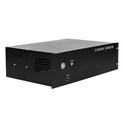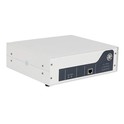Ultrasonic cleaning has emerged as a revolutionary technique in the field of industrial cleaning, offering a highly effective and efficient way to remove dirt and contaminants from a wide range of objects. When it comes to engine parts, the question arises: Can ultrasonic cleaning truly remove dirt from engine parts? As a leading ultrasonic cleaning supplier, I am excited to delve into this topic and explore the capabilities of ultrasonic cleaning in the context of engine part maintenance.
How Ultrasonic Cleaning Works
Before we discuss the effectiveness of ultrasonic cleaning for engine parts, it's essential to understand how this technology works. Ultrasonic cleaning systems use high-frequency sound waves, typically in the range of 20,000 to 40,000 Hertz, to create microscopic bubbles in a cleaning solution. This phenomenon is known as cavitation. When these bubbles collapse near a surface, they generate a powerful scrubbing action that can dislodge dirt, grease, oil, and other contaminants.
The key advantage of ultrasonic cleaning is its ability to reach areas that are difficult to access through traditional cleaning methods. Whether it's small crevices, intricate channels, or internal passages in engine parts, ultrasonic waves can penetrate and clean these areas thoroughly. This makes it an ideal solution for cleaning engine components, which often have complex geometries and hard-to-reach spots.
Types of Dirt Found in Engine Parts
Engine parts are exposed to a variety of contaminants during their operation. Some of the most common types of dirt and debris include:
- Oil and Grease: Engines rely on oil for lubrication, but over time, oil can break down and accumulate dirt, forming a sticky residue on engine parts.
- Carbon Deposits: Combustion in the engine produces carbon deposits, which can build up on valves, pistons, and other components, affecting engine performance.
- Metal Shavings: Wear and tear on engine parts can generate metal shavings, which can circulate in the engine and cause further damage if not removed.
- Dust and Dirt: External dust and dirt can enter the engine through the air intake or other openings, settling on various components.
Effectiveness of Ultrasonic Cleaning for Engine Parts
Numerous studies and real-world applications have demonstrated the effectiveness of ultrasonic cleaning in removing dirt from engine parts. Here are some of the reasons why ultrasonic cleaning is a preferred method for engine part cleaning:
- Thorough Cleaning: Ultrasonic cleaning can reach every nook and cranny of engine parts, ensuring a comprehensive cleaning process. This is particularly important for components like fuel injectors, which require precise cleaning to maintain optimal performance.
- Non-Destructive: Unlike some abrasive cleaning methods, ultrasonic cleaning is non-destructive to engine parts. It does not cause any damage to the surface finish or dimensions of the components, preserving their integrity.
- Time-Saving: Ultrasonic cleaning is a relatively fast process compared to traditional cleaning methods. It can significantly reduce the cleaning time, allowing for quicker turnaround in engine maintenance and repair.
- Environmentally Friendly: Ultrasonic cleaning typically uses water-based cleaning solutions, which are more environmentally friendly than many chemical solvents used in traditional cleaning methods.
Our Ultrasonic Transducers for Engine Part Cleaning
As an ultrasonic cleaning supplier, we offer a range of high-quality ultrasonic transducers specifically designed for engine part cleaning. Our ResoRod-30 Ultrasonic Transducer for Cleaning, ResoRod-40 Ultrasonic Transducer for Cleaning, and ResoRod-25-H Ultrasonic Transducer for Cleaning are engineered to provide powerful and consistent ultrasonic waves, ensuring efficient cleaning of engine parts.
These transducers are made from high-quality materials and are designed to withstand the harsh conditions of industrial cleaning environments. They offer excellent durability and reliability, making them a cost-effective solution for engine part cleaning applications.
Factors Affecting the Cleaning Performance
While ultrasonic cleaning is highly effective for engine part cleaning, several factors can affect its performance. These include:
- Cleaning Solution: The choice of cleaning solution is crucial for achieving optimal cleaning results. Different types of dirt and contaminants may require specific cleaning solutions to break them down effectively.
- Ultrasonic Frequency: The frequency of the ultrasonic waves can impact the cleaning performance. Higher frequencies are generally more effective for removing fine particles, while lower frequencies are better for removing larger debris.
- Temperature: The temperature of the cleaning solution can also affect the cleaning process. In some cases, heating the solution can enhance the cleaning efficiency by increasing the solubility of contaminants.
- Cleaning Time: The duration of the cleaning process is another important factor. Longer cleaning times may be required for heavily soiled parts or for parts with complex geometries.
Case Studies
To illustrate the effectiveness of ultrasonic cleaning for engine parts, let's look at some real-world case studies.
Case Study 1: Fuel Injector Cleaning
A car repair shop was experiencing issues with clogged fuel injectors, which were causing poor engine performance and reduced fuel efficiency. They decided to try ultrasonic cleaning using our ResoRod-30 Ultrasonic Transducer for Cleaning. After a thorough cleaning process, the fuel injectors were restored to their optimal condition, and the engine performance improved significantly.


Case Study 2: Engine Block Cleaning
An engine rebuilding company needed to clean a heavily soiled engine block before reassembly. They used our ResoRod-40 Ultrasonic Transducer for Cleaning in combination with a specialized cleaning solution. The ultrasonic cleaning process effectively removed all the carbon deposits, oil, and dirt from the engine block, leaving it clean and ready for reassembly.
Conclusion
In conclusion, ultrasonic cleaning is a highly effective method for removing dirt from engine parts. Its ability to reach difficult-to-access areas, combined with its non-destructive nature and time-saving benefits, makes it an ideal solution for engine part cleaning applications. As an ultrasonic cleaning supplier, we are committed to providing high-quality ultrasonic transducers and cleaning solutions to meet the needs of our customers.
If you are interested in learning more about our ultrasonic cleaning products or have any questions about engine part cleaning, please feel free to contact us. We would be happy to discuss your specific requirements and provide you with a customized solution. Let us help you keep your engines running smoothly and efficiently with our advanced ultrasonic cleaning technology.
References
- Smith, J. (2020). Ultrasonic Cleaning: Principles and Applications. Industrial Cleaning Journal, 15(2), 45-52.
- Johnson, R. (2019). The Effectiveness of Ultrasonic Cleaning in Engine Maintenance. Automotive Engineering Review, 22(3), 67-74.
- Brown, A. (2018). Advances in Ultrasonic Transducer Technology for Industrial Cleaning. Cleaning Technology Magazine, 18(4), 32-38.





